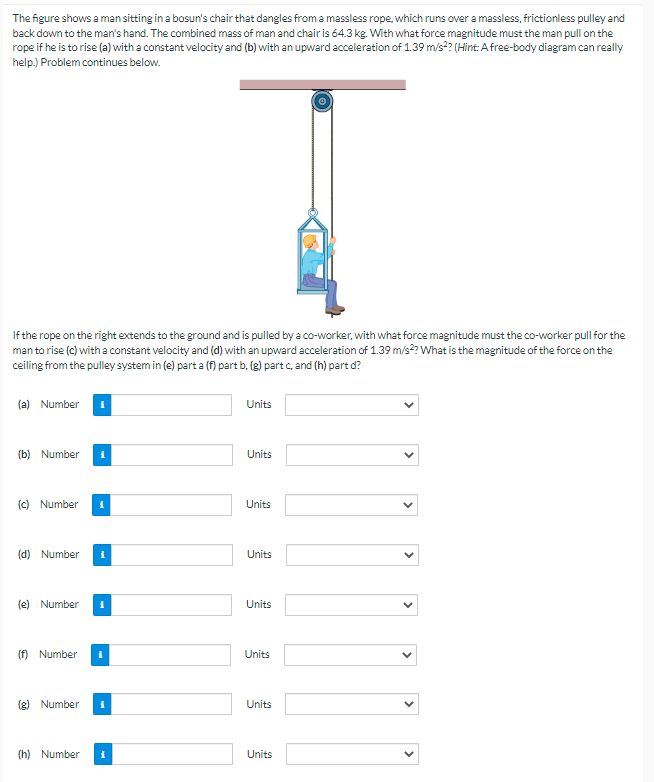The figure shows a man sitting in a bosun's chair that dangles from a massless rope, which runs over a massless, frictionless pulley and back down to the man's hand. The combined mass of man and chair is 64.3 kg. With what force magnitude must the man pull on the rope if he is to rise (a) with a constant velocity and (b) with an upward acceleration of 1.39 m/s2? (Hint: A free-body diagram can really help.) Problem continues below. If the rope on the right extends to the ground and is pulled by a co-worker, with what force magnitude must the co-worker pull for the man to rise (c) with a constant velocity and (d) with an upward acceleration of 1.39 m/s²? What is the magnitude of the force on the ceiling from the pulley system in (e) part a (f) part b. (g) part c, and (h) part d? (a) Number 1 (b) Number (c) Number (d) Number 1 (e) Number (f) Number (g) Number (h) Number Units Units Units Units Units Units Units Units <
The figure shows a man sitting in a bosun's chair that dangles from a massless rope, which runs over a massless, frictionless pulley and back down to the man's hand. The combined mass of man and chair is 64.3 kg. With what force magnitude must the man pull on the rope if he is to rise (a) with a constant velocity and (b) with an upward acceleration of 1.39 m/s2? (Hint: A free-body diagram can really help.) Problem continues below. If the rope on the right extends to the ground and is pulled by a co-worker, with what force magnitude must the co-worker pull for the man to rise (c) with a constant velocity and (d) with an upward acceleration of 1.39 m/s²? What is the magnitude of the force on the ceiling from the pulley system in (e) part a (f) part b. (g) part c, and (h) part d? (a) Number 1 (b) Number (c) Number (d) Number 1 (e) Number (f) Number (g) Number (h) Number Units Units Units Units Units Units Units Units <
College Physics
11th Edition
ISBN:9781305952300
Author:Raymond A. Serway, Chris Vuille
Publisher:Raymond A. Serway, Chris Vuille
Chapter4: Newton's Laws Of Motion
Section4.6: Applications Of Newton's Laws
Problem 4.9QQ: For the woman being pulled forward on the toboggan in Figure 4.33, is the magnitude of the normal...
Related questions
Topic Video
Question
100%

Transcribed Image Text:The figure shows a man sitting in a bosun's chair that dangles from a massless rope, which runs over a massless, frictionless pulley and
back down to the man's hand. The combined mass of man and chair is 64.3 kg. With what force magnitude must the man pull on the
rope if he is to rise (a) with a constant velocity and (b) with an upward acceleration of 1.39 m/s²? (Hint: A free-body diagram can really
help.) Problem continues below.
If the rope on the right extends to the ground and is pulled by a co-worker, with what force magnitude must the co-worker pull for the
man to rise (c) with a constant velocity and (d) with an upward acceleration of 1.39 m/s²? What is the magnitude of the force on the
ceiling from the pulley system in (e) part a (f) part b. (g) part c, and (h) part d?
(a) Number
(b) Number
(c) Number
(d) Number
(e) Number i
(f) Number
i
(g) Number
(h) Number i
Units
Units
Units
Units
Units
Units
Units
Units
Expert Solution
This question has been solved!
Explore an expertly crafted, step-by-step solution for a thorough understanding of key concepts.
This is a popular solution!
Trending now
This is a popular solution!
Step by step
Solved in 3 steps with 3 images

Knowledge Booster
Learn more about
Need a deep-dive on the concept behind this application? Look no further. Learn more about this topic, physics and related others by exploring similar questions and additional content below.Recommended textbooks for you

College Physics
Physics
ISBN:
9781305952300
Author:
Raymond A. Serway, Chris Vuille
Publisher:
Cengage Learning

College Physics
Physics
ISBN:
9781305952300
Author:
Raymond A. Serway, Chris Vuille
Publisher:
Cengage Learning